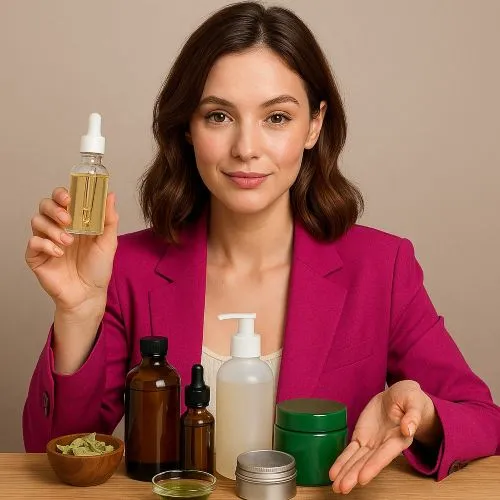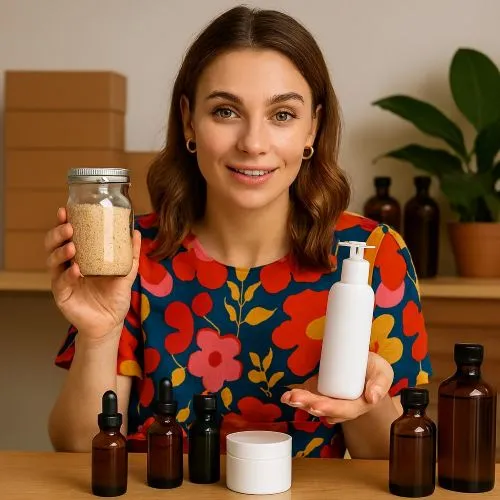-
 DIY: Video master classes
DIY: Video master classes
-
 Aromatherapy
Aromatherapy
-
 Felting master classes
Felting master classes
-
 Eating at home
Eating at home
-
 DIY cosmetics for children
DIY cosmetics for children
-
 Cooking recipes
Cooking recipes
-
 Detergents, cleaning products with your own hands
Detergents, cleaning products with your own hands
-
 Soap making as a business
Soap making as a business
-
 Natural cosmetics. Raw materials for cosmetics and soap.
Natural cosmetics. Raw materials for cosmetics and soap.
-
 Natural oils in cosmetics
Natural oils in cosmetics
-
 News
News
-
 Recipes for balms and conditioners
Recipes for balms and conditioners
-
 Bath Bomb Recipes
Bath Bomb Recipes
-
 Cream recipes. Cream making.
Cream recipes. Cream making.
-
 Lotion recipes. Gel recipes.
Lotion recipes. Gel recipes.
-
 Mask recipes
Mask recipes
-
 Soap recipes. Base soap. Soap from scratch.
Soap recipes. Base soap. Soap from scratch.
-
 Recipes for all occasions
Recipes for all occasions
-
 Natural shampoo recipes
Natural shampoo recipes
-
 Healthy Nutrition Recipes
Healthy Nutrition Recipes
-
 Scrub recipes. Massage tiles. Ubtan
Scrub recipes. Massage tiles. Ubtan
-
 DIY candles
DIY candles
-
 Reference materials, questions, tips
Reference materials, questions, tips
-
 Startup - soap production
Startup - soap production
-
 Hair care. Tips, recipes
Hair care. Tips, recipes
-
 Facial skin care. Cleansers.
Facial skin care. Cleansers.
-
 Body care. Tips, recipes
Body care. Tips, recipes
-
 Photo Reviews
Photo Reviews
-
 Chocolate Handmade
Chocolate Handmade
Where to get high-quality raw materials for cosmetics with wholesale prices and certificates
 For any cosmetic formulator, whether a hobbyist or a small business owner, the quality of your raw materials is the single most important factor determining the safety and effectiveness of your final product. The difference between a professional-grade formula and a failed experiment often comes down to the purity and potency of its ingredients. Finding reliable suppliers who offer high-quality raw materials with wholesale prices and certificates can be a daunting task. This article provides a comprehensive guide to navigating the world of cosmetic ingredient sourcing, explaining what to look for, where to find it, and why every detail matters. We'll also provide three recipes that highlight how sourcing premium ingredients can elevate your products.
For any cosmetic formulator, whether a hobbyist or a small business owner, the quality of your raw materials is the single most important factor determining the safety and effectiveness of your final product. The difference between a professional-grade formula and a failed experiment often comes down to the purity and potency of its ingredients. Finding reliable suppliers who offer high-quality raw materials with wholesale prices and certificates can be a daunting task. This article provides a comprehensive guide to navigating the world of cosmetic ingredient sourcing, explaining what to look for, where to find it, and why every detail matters. We'll also provide three recipes that highlight how sourcing premium ingredients can elevate your products.
The Importance of Quality and Certification
Why does sourcing matter so much? The effectiveness of an active ingredient, the stability of an emulsion, and the safety of a product all depend on the raw materials used.
-
Efficacy and Purity: High-quality ingredients are more potent and predictable. A peptide from a reputable supplier will be pure and stable, delivering its intended benefits. A botanical extract from an uncertified source, however, might contain contaminants or be of a lower concentration, rendering it ineffective.
-
Safety: Certificates of Analysis (COA) and Safety Data Sheets (SDS) are non-negotiable. A COA confirms the ingredient's purity, batch number, and key characteristics. An SDS provides crucial information on how to handle the ingredient safely. Without these documents, you are taking a significant risk.
-
Consistency: When scaling up your production, consistency is key. A reliable supplier ensures that every batch of an ingredient has the same quality and characteristics, which is vital for maintaining a stable and consistent product line.
Where to Find Reputable Suppliers
Finding a good supplier is a process of research and due diligence. You can categorize suppliers into a few main groups.
-
Local and Regional Suppliers: This is often the best starting point for hobbyists. These companies typically offer a wide range of ingredients in smaller quantities. They are great for experimenting with new formulas and minimizing your initial investment. Look for suppliers that are transparent about their sourcing and provide documentation upon request.
-
National and International Distributors: As your brand grows, you'll need to source ingredients in larger, wholesale quantities. Companies like Making Cosmetics, Formulator Sample Shop, and The Herbarie offer a vast selection, detailed product descriptions, and the necessary certificates. They are a reliable source for high-volume purchases.
-
Direct from Manufacturers: For very large-scale production, you can go directly to the ingredient manufacturers. This requires a significant financial commitment but gives you access to the best prices and the most detailed technical support.
Key Questions to Ask Suppliers:
-
Do you provide Certificates of Analysis (COA) for your ingredients?
-
What are your minimum order quantities (MOQ)?
-
Do you offer wholesale or bulk pricing?
-
What are your shipping and return policies?
Three Recipes with Sourcing Recommendations
These recipes demonstrate how using high-quality, certified ingredients can make a difference in your final product.
Recipe 1: Professional-Grade Anti-Aging Serum
This serum highlights the importance of sourcing certified actives like peptides and Vitamin C derivatives.
-
Prepare the water phase. In a sterilized beaker, weigh 85g of distilled water.
-
Hydrate the gelling agent. Slowly sprinkle 0.5g of Xanthan Gum over the water and stir until a smooth gel forms. Let it sit for 30 minutes to an hour.
-
Add premium actives. Once the gel is formed, add 2g of Matrixyl 3000 peptide solution (from a certified supplier) and 5g of Sodium Ascorbyl Phosphate (a stable Vitamin C derivative). Stir gently to dissolve.
-
Add a quality humectant. Add 5g of vegetable glycerin (a pure, food-grade source).
-
Add preservative and adjust pH. Add 1g of a broad-spectrum preservative like Euxyl PE 9010. Check the pH and adjust to between 5.0 and 6.0 with a few drops of lactic acid.
Sourcing Recommendations: Look for peptide solutions from well-known cosmetic ingredient suppliers. Verify their COA to ensure the peptide concentration is accurate.
Recipe 2: Hydrating Emulsified Body Butter
This body butter demonstrates how sourcing premium butters and oils impacts the feel and efficacy of a product.
-
Prepare the oil phase. In a heat-safe beaker, weigh 40g of certified organic shea butter and 15g of cocoa butter. Add 5g of a reliable emulsifier like Emulsifying Wax NF. Gently melt in a double boiler.
-
Prepare the water phase. In a separate beaker, weigh 35g of distilled water and 5g of vegetable glycerin. Heat to 70°C.
-
Emulsify. Once the oil phase is melted, remove it from the heat. Pour the hot water phase into the oil phase while mixing with a hand blender in short pulses until a thick, smooth emulsion forms.
-
Add a precious oil. When the mixture has cooled below 40°C, add 5g of cold-pressed rosehip seed oil. This sensitive oil should not be heated.
-
Preserve and pour. Add 1g of a broad-spectrum preservative. Stir well and transfer the body butter to a jar.
Sourcing Recommendations: Choose butters and oils from suppliers that specify their extraction method (e.g., cold-pressed) and provide COA to confirm purity.
Recipe 3: Soothing and Protective Lip Balm
This simple balm showcases how even basic ingredients like waxes and butters benefit from certified quality.
-
Prepare the wax and butter phase. In a heat-safe beaker, weigh 10g of cosmetic-grade beeswax pellets and 15g of cocoa butter. Gently melt them in a double boiler.
-
Add oils. Once melted, remove from heat and add 15g of sweet almond oil and 5g of avocado oil. Stir to combine.
-
Add a quality active. When the mixture is still liquid but has cooled slightly, add 1g of high-quality Vitamin E (Tocopherol). This acts as both an antioxidant for your product and a skin-soothing active.
-
Add flavor and pour. Add 5-10 drops of a cosmetic-grade flavor oil. Pour the liquid balm into clean lip balm tubes or pots.
Sourcing Recommendations: Choose beeswax and butters that are filtered and certified for cosmetic use. Avoid using wax from unknown sources, which may contain impurities.
Advantages of a DIY Brand with a Focus on Quality Sourcing

Building a brand with a focus on sourcing high-quality, certified ingredients provides significant advantages over industrial, mass-market products.
-
Superior Efficacy: Your products will genuinely work as advertised because the actives are pure and potent. You can confidently claim that your products contain what they say they do.
-
Safety and Reliability: By using ingredients with documented purity and safety, you minimize the risk of skin reactions and ensure your products are safe for your customers.
-
Ingredient Transparency: You can provide your customers with a clear, honest ingredient list and explain where you source your materials, building trust and a loyal customer base.
-
Cost-Effectiveness at Scale: While quality ingredients may seem more expensive initially, buying them in bulk from wholesale suppliers significantly reduces the cost per unit, allowing you to maintain profitability while offering a premium product.
By dedicating time and effort to sourcing, you lay the foundation for a brand that is built on integrity, quality, and efficacy. This is the ultimate advantage in a competitive market.
Mylo Opt Cosmetics Blog – Your Reliable Guide to Beauty and Care
Welcome to the Mylo Opt cosmetics blog! Here, you will find valuable advice, interesting recipes, and professional recommendations for creating soap, cosmetics, and candles with your own hands. Our blog is designed for anyone passionate about natural cosmetics, looking for new ideas, and wanting to learn more about producing high-quality skincare and haircare products. We share tested recipes, useful tips, and the latest news from the world of cosmetics.
Why Choose the Mylo Opt Cosmetics Blog?
Mylo Opt is not just an online store; it is a community of people passionate about creating natural cosmetics. Here are a few reasons why our blog will be useful to you:
- Experience and Expertise: Our authors are experienced cosmetologists, soap makers, and aromatherapy specialists. We share reliable and tested recipes that have undergone thorough testing and received positive feedback.
- Credibility and Authority: We ensure that all information in our blog is up-to-date and reliable. We reference scientific research and verified sources so that you can trust the quality of the information provided.
- Reader-Focused: Our content is tailored to you – our readers. We strive to answer your questions, solve your problems, and inspire new achievements in the world of natural cosmetics.
Popular Products from the Mylo Opt Online Store
Before we move on to recipes and tips, let us introduce you to the most popular products from our online store, which will help you create high-quality and natural cosmetics:
- Soap Bases: High-quality soap bases allow you to create beautiful and beneficial handmade soaps. We offer glycerin bases, bases with added oils and extracts, as well as transparent and white bases.
- Fragrance Oils and Fragrances: Give your products a unique scent with our fragrance oils and fragrances. We offer a wide range of scents – from fresh and floral to spicy and woody.
- Essential Oils: Essential oils are natural components that not only add fragrance to products but also offer beneficial properties for the skin and hair. Our range includes lavender, mint, eucalyptus, lemon, and many other oils.
- Active Ingredients: Vitamins, antioxidants, hyaluronic acid, and other active ingredients help improve the properties of your cosmetics. We offer only tested and high-quality components.
- Pigments and Dyes: Give your products bright and lasting colors with our pigments and dyes. They are safe for the skin and suitable for use in soap, cosmetics, and candles.
- Emulsifiers and Thickeners: To create creams and lotions, you will need emulsifiers and thickeners. We offer quality ingredients that help you achieve the desired consistency and stability of the product.
- Soap and Candle Molds: Create unique items with our soap and candle molds. Our range includes molds of various sizes and designs.
- Everything for Candles: Wax, wicks, fragrances, and dyes for candles – we have everything you need to create beautiful and fragrant candles.
Recipes and Tips for Making Handmade Soap
Cold Process Soap for Beginners
Making cold process soap is an exciting process that allows you to control all the ingredients and create unique recipes. Here is one simple cold process soap recipe for beginners:
Ingredients:
- 500 g olive oil
- 300 g coconut oil
- 200 g palm oil
- 150 g castor oil
- 120 g lye (sodium hydroxide)
- 300 ml distilled water
- Essential oils (lavender, mint, eucalyptus)
- Pigments or natural dyes (optional)
Process:
- Prepare all ingredients and tools. Always use protective gloves and goggles, as lye can be dangerous.
- Weigh the lye and water. Slowly add the lye to the water, stirring until it fully dissolves. Allow the mixture to cool to 40-45°C.
- Weigh the oils and melt them in a water bath. When the oils and lye solution reach the same temperature (about 40-45°C), slowly pour the lye into the oils, stirring constantly.
- Use an immersion blender to mix until trace (when the mixture thickens and leaves a trail when stirred).
- Add essential oils and pigments if desired. Mix thoroughly.
- Pour the mixture into a prepared mold and cover with a towel. Let the soap harden for 24-48 hours.
- Remove the soap from the mold and cut it into bars. Allow the soap to cure for 4-6 weeks before use.
Homemade Cosmetics Recipes
DIY Moisturizing Cream
Creating a moisturizing cream at home allows you to control the ingredients and adapt the recipe to your needs. Here is a simple recipe for a moisturizing cream:
Ingredients:
- 50 ml rose water
- 50 ml distilled water
- 10 g emulsifier (e.g., Olivem 1000)
- 10 ml jojoba oil
- 5 ml avocado oil
- 5 drops lavender essential oil
- 2 drops tea tree essential oil
Process:
- Weigh all the ingredients.
- In a water bath, melt the emulsifier with the oils until smooth.
- Separately, heat the water phase (rose water and distilled water) to the same temperature as the oil phase.
- Slowly pour the water phase into the oil phase, stirring constantly.
- Use an immersion blender to emulsify until you achieve a creamy consistency.
- Add essential oils and mix thoroughly.
- Pour the cream into a sterilized jar and allow it to cool.
DIY Candle Recipes
Aromatic Soy Candle
Creating aromatic candles is a creative process that allows you to experiment with scents and designs. Here is a simple recipe for a soy candle:
Ingredients:
- 200 g soy wax
- 20 ml fragrance oil (e.g., vanilla or lavender)
- Wick for candles
- Dyes (optional)
- Glass or metal candle mold
Process:
- Melt the soy wax in a water bath until liquid.
- Add the fragrance oil and dyes if desired. Mix thoroughly.
- Secure the wick in the center of the candle mold.
- Slowly pour the melted wax into the mold, holding the wick.
- Allow the candle to fully harden (about 24 hours).
- Trim the wick to the desired length and enjoy your aromatic candle.
Tips for Beginners in Cream Making
- Learn the Basics: Before starting to create creams, it is important to learn the basic principles and ingredients used in cream making.
- Experiment with Formulas: Do not be afraid to experiment with different ingredients and proportions to find the perfect formula for your skin.
- Use Quality Ingredients: The effectiveness and safety of your product depend on the quality of the ingredients. Always choose tested and natural components.
- Maintain Hygiene: It is important to maintain cleanliness and sterility when creating cosmetics to avoid contamination and spoilage of the product.
- Start with Simple Recipes: For beginners, it is best to start with simple recipes to master the basic techniques and principles of cream making.
Conclusion
Our Mylo Opt cosmetics blog is your reliable source of information and inspiration in the world of natural cosmetics. We share useful tips, tested recipes, and the latest news to help you create quality and effective products for skin, hair, and home care. Subscribe to our blog, follow the updates, and discover new opportunities in the world of natural cosmetics with Mylo Opt!





